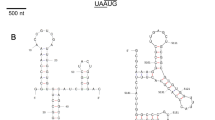Abstract
Chinese bayberry is a fruit that is appreciated for its taste. A novel totivirus associated with rolling, disfiguring, chlorotic and vein-clearing symptoms on the leaf apices of Chinese bayberry was identified by transcriptome sequencing and reverse transcription PCR (RT-PCR). The complete genome of the virus was determined to be 4959 nucleotides long, and it contains two open reading frames (ORFs). Its genomic organization is similar to that of previously reported totiviruses. ORF1 encodes a putative coat protein (CP) of 765 aa, and ORF2 encodes an RNA-dependent RNA polymerase (RdRp) of 815 aa. These two putative proteins share 55.1% and 62.6%, amino acid sequence identity, respectively, with the corresponding proteins of Panax notoginseng virus A, respectively. According to the demarcation criteria for totivirus species established by the International Committee on Taxonomy of Viruses (ICTV), the new virus should be considered a member of a new species in the genus totivirus, family Orthototiviridae, which we have tentatively named ‘‘Myrica rubra-associated totivirus’’ (MRaTV).



Similar content being viewed by others
Data availability
The dataset generated in the current study is available in the GenBank database (accession no. OR08807).
References
Xia W, Gong E, Lin Y et al (2021) Comparison of phytochemical profiles, antioxidant and antiproliferative activities in Chinese bayberry (Myrica rubra Sieb. et Zucc.) fruits. J Food Sci 86(10):4691–4703. https://doi.org/10.1111/1750-3841.15899
Zhang H, Gui MY (2007) Storage fungous diseases of Myrica rubra of Yunnan[J]. J Yunnan Agric Univ 04:503–506. https://doi.org/10.16211/j.issn.1004-390x(n).2007.04.024
Wang ZR (2013) Disease survey, pathogen identification and disease control methods in Morella rubra in Cixi. Yangzhou University, Zhejiang Province
Fang HS, Cao RB (1984) Identification of causal organism of bacterial gall of bayberry. J Zhejiang Agric Univ 03:73–78
Yu H, Tian S, Huang Q et al (2021) An insect- and rain-proof net raises the production and quality of Chinese bayberry by preventing damage from insects and altering bacterial communities. Front Plant Sci 12:732012. https://doi.org/10.3389/fpls.2021.732012
Gao L, Anane RF, Chen Z, He Y, Li S, Zi S, Yang Z, Chu B, Wen G, Zhao M (2023) Complete genome sequence analysis of a novel citlodavirus isolated from the leaves of Myrica rubra in Yunnan. Adv Virol 168(5):139. https://doi.org/10.1007/s00705-023-05762-1
Wickner RB, Ghabrial SA, Nibert ML (2012) Family Totiviridae. In virus taxonomy: classification and nomenclature of viruses: ninth report of the international committee on taxonomy of viruses; King AMQ, Adams MJ, Carstens EB, Lefkowits EJ, Eds. Elsevier Academic Press, London, UK, pp 639–650
Bolger AM, Lohse M, Usadel B (2014) Trimmomatic: a flexible trimmer for Illumina sequence data. Bioinformatics (Oxford, England) 30(15):2114–2120
Grabherr MG, Haas BJ, Yassour M, Levin JZ, Thompson DA, Amit I, Adiconis X, Fan L, Raychowdhury R, Zeng Q, Chen Z, Mauceli E, Hacohen N, Gnirke A, Rhind N, di Palma F, Birren BW, Nusbaum C, Lindblad-Toh K, Friedman N, … Regev A (2011) Full-length transcriptome assembly from RNA-Seq data without a reference genome. Nat Biotechnol 29(7):644–652. https://doi.org/10.1038/nbt.1883
Zhang ZY, Huang H, Han XX et al (2021) Identification and molecular characterization of tea-oil camellia-associated totivirus 1. Adv Virol 166(8):2347–2351. https://doi.org/10.1007/s00705-021-05058-2
Akinyemi IA, Wang F, Chang ZX (2018) Genome characterization of the newly identified maize-associated totivirus Anhui. Adv Virol 163(10):2929–2931. https://doi.org/10.1007/s00705-018-3929-0
Huang CH, Lu CL, Chiu HT et al (2005) A heuristic approach for detecting RNA H-type pseudoknots. Bioinformatics (Oxford, England) 21(17):3501–3508. https://doi.org/10.1093/bioinformatics/bti568
Ghabrial SA, Suzuki N (2009) Viruses of plant pathogenic fungi. Annu Rev Phytopathol 47:353–384. https://doi.org/10.1146/annurev-phyto-080508-081932
Funding
This research was funded by Yunnan Provincial Science and Technology Department-Applied Basic Research Joint Special Funds of Yunnan University of Chinese Medicine (202101AZ070001-011) and High-Level Talents Project of Yunnan University of Chinese Medicine (2019YZG09).
Author information
Authors and Affiliations
Contributions
WL and JD conceived and designed the experiments. PJ and JD collected the samples. KW, LZ, and WL performed the experiments. LZ and XD analyzed the data. WL and JD wrote the paper. All authors have read and agreed to the published version of the manuscript.
Corresponding authors
Ethics declarations
Conflict of interest
All authors declare no conflict of interest.
Additional information
Handling Editor: Massimo Turina
Publisher's Note
Springer Nature remains neutral with regard to jurisdictional claims in published maps and institutional affiliations.
Supplementary Information
Below is the link to the electronic supplementary material.
Rights and permissions
Springer Nature or its licensor (e.g. a society or other partner) holds exclusive rights to this article under a publishing agreement with the author(s) or other rightsholder(s); author self-archiving of the accepted manuscript version of this article is solely governed by the terms of such publishing agreement and applicable law.
About this article
Cite this article
Luo, W., Zhang, L., Zhang, L. et al. Complete genome sequence of a novel totivirus isolated from the leaves of Myrica rubra. Arch Virol 169, 123 (2024). https://doi.org/10.1007/s00705-024-06048-w
Received:
Accepted:
Published:
DOI: https://doi.org/10.1007/s00705-024-06048-w




